How to Hold And Play With a Guitar Pick
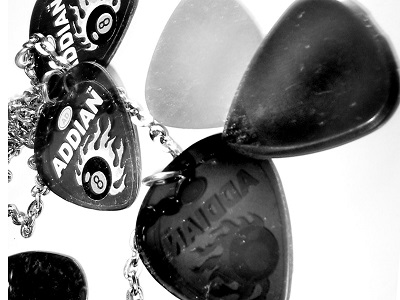 When playing an electric guitar, the pick is one of the most important tools for the guitarist. For the benefit of those who do not know what guitar picks are, I will spend some time introducing the various types of guitar picks available in the market.
When playing an electric guitar, the pick is one of the most important tools for the guitarist. For the benefit of those who do not know what guitar picks are, I will spend some time introducing the various types of guitar picks available in the market.
In general, a guitar pick is a triangular shaped piece of hard material to aid the guitarist in strumming and picking the strings. These guitar picks can be made of various materials such as metal, bone, wood but are most commonly available in the plastic form commercially.
You can easily purchase guitar picks from any music store and they come in various sizes and gauges (hardness). In my opinion, the size of the guitar pick is really up to individual preferences and finger sizes.
If you are unsure about what to buy, I would recommend getting guitar picks that are roughly 2cm by 2cm in size as they would fit nicely in most fingers. Also, be sure to invest in at least 10-15 picks as they get lost easily and you don’t want to find yourself in a situation without a spare pick.
What Type of Hardness in a Guitar Pick is Ideal?
The other aspect of choosing picks lies in their gauge/hardness. Depending on the type of tone and style of guitar playing, various gauges of picks have their different applications.
| Light | Medium | Heavy |
|---|---|---|
| Very flexible | Slightly flexible | Cannot be flexed |
| Short wear life | Medium wear life | Long wear life |
| Soft sounding | Medium sounding | Bright sounding |
| Good for strumming | Mixture of strumming and soloing | Good for lead guitar |
With heavier picks, you can dictate the tone of your guitar playing by controlling your picking strength. However, if you are using heavy gauge guitar picks for rhythm playing, you will realize that the picks can fly off your hand easily.
This is due to the rigidity of the pick which causes the strumming impact to be absorbed by the fingers. As a result, it causes the fingers to lose grip of the pick easily.
On the contrary, the use of lighter picks to play rhythm guitar can help overcome this problem. The downside of ultra light picks is that it is impossible to play fast solos due to the flexible nature of the guitar pick.
6 Major Rules on How to Hold And Play With a Guitar Pick
#1 – Grip the pick with 2 fingers. Use the illustration as a guide and find your own sweet spot. (DO NOT use 3 fingers as recommended by some so called guitar gurus) This is because using 2 fingers will keep your picking hand in a proper posture for better strumming and lead guitar playing techniques (hybrid picking, alternate picking etc…).
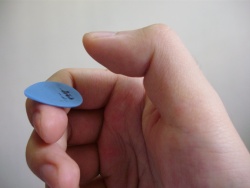

#2 – Apply moderate pressure when gripping the pick. Too low pressure will cause the guitar pick to slide around whereas too high pressure will hinder your hand movements.
#3 – If you are strumming with a pick, use a light or medium gauge pick and hold the pick in a way where only 1/3 of the pick is exposed.
#4 – If you are playing individual strings (i.e. soloing), show as little of the tip as possible and use a heavy pick. You will see an immediate improvement on the tone of your playing as well as gain better control when playing fast.
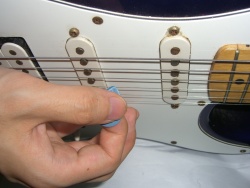
Correct
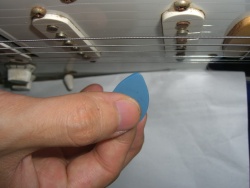
Wrong
#5 – Regardless of strumming or lead guitar playing, the picking motion should always come from the wrist and NOT from the fingers or the elbow.
#6 – To enhance your picking accuracy, try anchoring your pinky to the pick guard as shown in the image below. This will help your hand get a feel of where the strings are and reduce picking errors.
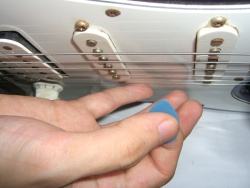
If you are a complete beginner at playing the guitar, the use of a guitar pick may be quite awkward initially. With time and practice, you will get used to it and find that playing with a guitar pick is not as hard as it seems.
Final notes for this lesson: You should always carry a couple of different picks of sizes and gauges around so that you can use them for different purposes. Also, guitar picks tend to get lost easily and you might want to devise a method to store your picks after usage. If not, you’ll end up purchasing a whole box of picks just like me. (Sometimes, I recover lost guitar picks in the weirdest places at home. Haha…)







Leave A Comment